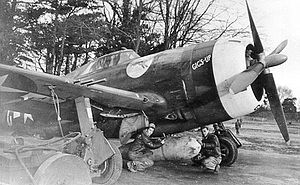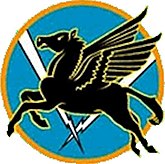|
486th Fighter Squadron
The 486th Fighter Squadron is an inactive United States Air Force unit. It activated during World War II and was assigned to the 352nd Fighter Group of VIII Fighter Command. After training in the United States, it deployed to the European Theater of Operations, where it earned a Distinguished Unit Citation and a French Croix de Guerre with Palm for its combat actions. Following V-E Day, it returned to the United States and was inactivated at the port of embarkation, Camp Kilmer, New Jersey, on 9 November 1945. HistoryFormation and training in the United StatesThe Adjutant General directed the activation of the 352nd Fighter Group on 1 October 1942. Among its components was the 21st Fighter Squadron, formed by redesignating the 21st Pursuit Squadron as the 21st Fighter Squadron. The squadron began training under that designation.[3] Just before the squadron shipped overseas, in May 1943, headquarters[clarification needed] became aware that the 21st Pursuit Squadron, whose personnel were all in Japanese POW camps, was still being maintained on the rolls of the United States Army as an active unit: that there were two 21st Pursuit or Fighter Squadrons. As a result, the designation as the 21st Fighter Squadron was revoked.[4] The squadron was retroactively[citation needed] activated as the 486th Fighter Squadron.[note 2] However, because the original directive was revoked, the 21st Pursuit Squadron and the 486th Fighter Squadron are not related under U.S. Army lineage rules.[5] The squadron was activated at Mitchel Field, New York, although its formation occurred at Bradley Field, Connecticut. and it trained with Republic P-47 Thunderbolts at various bases in the northeast United States. While training, the squadron also served in the air defense of the northeast as part of the New York Fighter Wing.[6][7] In mid-June 1943, the squadron moved to Camp Kilmer and sailed on the RMS Queen Elizabeth for England on 1 July.[8] Combat in the European Theater The squadron flew its first combat mission on 9 September 1943.[8] It concentrated on flying escort missions for VIII Bomber Command heavy bombers participating in the strategic bombing campaign against Germany. From 20 February to 25 February 1945, it flew cover for bombers involved in the Big Week campaign against the German aircraft manufacturing industry.[6] In April 1944 the squadron began to replace its Thunderbolts with longer range North American P-51D Mustangs. On 8 May, the squadron was escorting bombers on a raid on Braunschweig. It routed an attack by a numerically superior force of German interceptors, continuing the fight until most planes had used all their ammunition and were running short on fuel, requiring the unit to return to base. For this action, the squadron was awarded the Distinguished Unit Citation. In addition to escort missions, the squadron flew counter air missions. Returning from its escort missions, it often engaged in air interdiction attacks.[6] The squadron was sent to RAF Debden in June to reinforce the 4th Fighter Group, providing top cover for Boeing B-17 Flying Fortresses in Operation Frantic, the shuttle mission from England to the Soviet Union. Other units protected the bombers on the way to the target, an oil facility near Berlin. The squadron rendezvoused with the bombers over Poland and defended them against an attack by 20 Focke-Wulf Fw 190 fighters. P-51 maintenance personnel had flown as gunners on the bombers, and were available to ready the squadron's planes for an escort mission attacking a target in Yugoslavia. Before returning to England, the squadron participated in missions in the Balkans, operating from Italy after the first mission.[9] As the German Army launched the counteroffensive known as the Battle of the Bulge, a detachment of the squadron that included all of its air echelon deployed to Asch Airfield on 23 December 1944 to reinforce Ninth Air Force flying air support missions. On 1 January the detachment earned the squadron the French Croix de Guerre with Palm, when its airfield was attacked by 50 Luftwaffe fighter aircraft, just as its planes were taking off for an area patrol. In the ensuing aerial battle, about half the attacking German aircraft were destroyed with no loss to the squadron. The detachment moved to Chievres Airfield, Belgium in late January 1945, where it was joined by the rest of the squadron, coming under the control of Eighth Air Force again. From Chievres, it provided cover for Operation Varsity, the airborne assault to establish a bridgehead across the Rhine.[6] In April 1945, the squadron returned to England, flying its last mission on 3 May.[8] It was credited with the destruction of 115 enemy aircraft in combat.[10] Following V-E Day, many of the squadron personnel transferred for early return to the United States. The remaining personnel sailed on the RMS Queen Mary on 4 November 1945. After arriving in the United States, the squadron inactivated on 10 November 1945.[6][8] Lineage
Assignments
Stations
Aircraft
Awards and campaigns
ReferencesNotes
Bibliography
|
||||||||||||||||||||||||||||||||||||||||||||||||||||||||||||||||||||||

